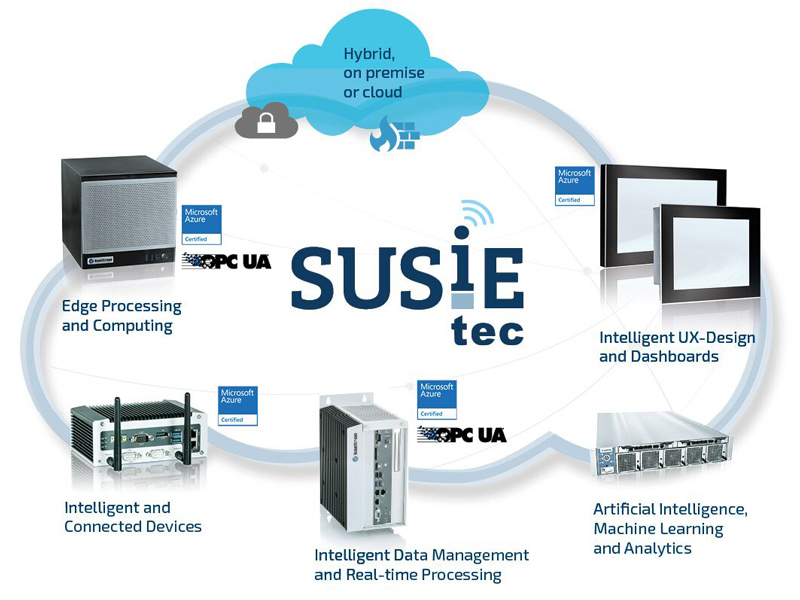Edge computers make AI applications ready for large-scale use
The cooperation between the companies within the S&T Group opens up many new fields of applications. With the IoT Software Framework SUSiEtec from S&T Technologies, Kontron can offer artificial intelligence (AI) solutions for its edge computers from a single source, such as for instance for Visual Inspection. This is where Kontron benefits from its many years of experience as a manufacturer of high-performance, state-of-the-art industrial computers based on the latest processor technology.
In addition to machine control, edge computers also perform other key tasks: on the one hand, they serve as gateways into the network extending onto the Internet. On the other hand, powerful embedded computers can take on demanding tasks directly at the machine that cannot be performed in the cloud due to latency times and bandwidth restrictions, such as AI applications.
In the field of visual inspection, for example, recordings via a camera are analysed and evaluated directly on the edge device by a trained neural network, connected either by USB or network in a process called ‘Inference’ - more precisely than humans would be able to do.
Other possible applications for computers with edge performance are machine and deep learning, in whose compute-intensive processes pre-configured neural networks are usually trained to fulfill dedicated applications. Implementing this on the edge side is usually more efficient than uploading terabytes of training material into the cloud.
A complete process for deep learning consists of different phases:
Hit rate greater than 80% required
According to customer experiences of S&T Technologies, customers expect a finished product in most cases, for example when it comes to object recognition. A "minimum viable product" that meets the minimum requirements must have a hit rate of at least 80 percent.
The application fields are diverse:
- Supermarket scales should be able to automatically recognise which type of fruit or vegetable is being weighed; therefore, customers no longer must remember the corresponding item numbers and enter them manually. Employees at the checkout no longer must check whether the customer has determined the correct price.
- When it comes to professional permanent hair removal via laser at the dermatologist, the device can automatically recognise which skin type it should adjust to. A complex examination and adjustment by the doctor is no longer necessary.
- For repairs and maintenance, a photo of the part to be replaced or defective is sufficient for the software or app to correctly identify the part and, if necessary, immediately trigger the re-order of the spare part.

Simple programming of AI applications
S&T Technologies often experiences that companies already have tried and tested visual inspection systems in operation. These have sometimes been in use for well over ten years and are therefore perfectly tailored to the application. New AI solutions naturally have a hard time asserting themselves against established systems. Often the knowledge of an efficient programming language for the development of a new solution is missing. Here, the AI Software Framework SUSiEtec offers an alternative: it allows developers to program the learning and inference phase in the common languages .Net and Java by Windows.
On the hardware side, it shows that embedded computers are very well equipped for AI tasks, because in practice the evaluation speed often plays only a minor role: the difference between a tenth of a second and two seconds is often not decisive for the application. Powerful hardware accelerators such as Intel Movidius chips for neural networks are therefore usually required in time-critical scenarios, but not in every application.
In addition to visual inspection, AI applications are also conceivable in text recognition and reproduction, audio recognition and behavior pattern recognition. Audio recognition for instance can be used to identify unusual vibrations that indicate a faulty machine part. For example, trains could be checked "in passing". Sooner or later, firewalls in IT networks will "learn" what normal behavior is in the network and give alerts or even initiate protective and defensive measures if activities are detected as unusual.
AI tailor-made for all application fields
The basic research of many Internet companies as well as from universities such as Harvard and other research institutes contribute further to the development of AI applications. On this basis, commercial companies can now also implement their own applications: this is where Kontron and S&T Technologies step into the picture. They enable their customers to concentrate on their core competencies and implement state-of-the-art technologies tailored to the customer's needs, such as automated image searches on an Internet search engine. The same neural networks are used when an S&T Technologies AI application categorises products. Of course, the application is executed and accelerated on Kontron hardware. In principle, Kontron and S&T Technologies consider the market ripe for scalable AI solutions, as all components are available "off the shelf". In addition, the S&T Group supports its customers in entering this new technology with the IoT Software Framework SUSiEtec. In the case of visual recognition, as a prominent example, this includes clarifying hardware requirements, selecting and integrating open source modules and packages and encapsulating complex problems, e.g. via dockers. This enormous complexity often results in many small problems during interaction, which can then be solved by Kontron together with the S&T Group for the customer. The customer is accompanied throughout his entire journey from consulting to a finished, tailor-made "product".
Starting with small, successful solutions, this results in comprehensive applications that bring real added value to the customer. A wide range of AI applications are not only imaginable today but can in fact already be implemented.










